Huitlacoche and Frida
Over 20 million people live in the greater Mexico City area. Like any megalopolis, Mexico City can seem overwhelming, loud, dirty, and gridlocked. But, there are quiet, tree-lined, quaint neighborhoods as well.
A Short History
The Aztecs founded the city-state of Tenochtitlan in 1325 in the area now known of Mexico City. The city grew and became the capital of the Aztec Empire until Spanish contact in 1519 when the city had a population of between 200,000 and 300,000 people, making it one of the largest cities in the world and five times the size of London at the time.
The Spanish laid siege to the city during which many Aztecs died of starvation and smallpox. In the final stage of the siege, the Spanish defeated the Aztecs and destroyed the city, building their own city on the ruins of Tenochtitlan using forced labor.
The city expanded and grew significantly during the Porfirio era in the late 19th century. Then, during the Mexican Revolution, Mexico City escaped most of the war’s violence. Pancho Villa’s army eventually entered the city, but with no violence.
Since 1900, the city has grown from a population of 500,000 to today’s metro count of over 21 million people.
Frida and Trotsky
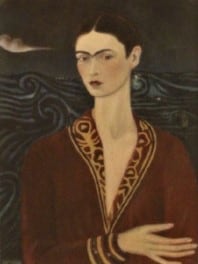
Coyoacán is one of those neighborhoods. Parks, plazas, shops and bookstores serving the large university population make Coyoacán seem like a village unto itself. And for a long time, it was. It was only in the mid-20th century, when Mexico City’s sprawl swallowed up Coyoacán that it became a borough of the city.
We wanted to visit Coyoacán because of the museums, specifically one museum, La Casa Azul, the Blue House, where Frida Kahlo was born, lived and worked, and in 1954, died. We were staying at a hotel on the Zócalo, Constitution Plaza, so we splurged on a driver for the day since there were a lot of things we wanted to see and public transit would be too slow.
The Frida Kahlo Museum is in a newer part of Coyoacán, called Colonia del Carmen. The house itself is a revelation. Built in 1904, Frida was born here in 1907. The house surrounds an interior courtyard that is filled with trees, plants and areas to sit and contemplate Frida’s life and work. Inside, each room is packed with artwork and artifacts. There’s a display of Frida’s dresses that defined her iconic style. Other rooms contain Frida’s personal effects like her wheelchair and prosthetic leg. The kitchen looks much like it did in 1951 and some of the other rooms are filled with artwork from artists that Frida admired.

But, the main draw is the paintings by Frida. There are masterpieces like Viva la Vida, lesser known works like Portrait of My Father, and unfinished works like her portrait of Stalin from 1954, painted as she was heavily medicated and dying.
Here’s an interesting thing about Frida and Stalin and the Soviet Union. Stalin was a hero of Frida’s because of the Red Army’s defeat of the Nazis. But, before that, in the 1920s, Stalin consolidated power and exiled or jailed his political opponents, many of whom were original architects of the revolution. Leon Trotsky was one of those political enemies. After his exile in 1929, he bounced around Europe, getting kicked out of other countries for his political organizing, until he finally landed in Mexico in 1937.
Frida Kahlo and her husband Diego Rivera were avowed Communists and took in Trotsky and his wife allowing them to live in the Blue House until 1939 when the Trotskys moved to another house around the corner. Multiple published accounts say the reason for the split was an adulterous affair between Frida and Leon.
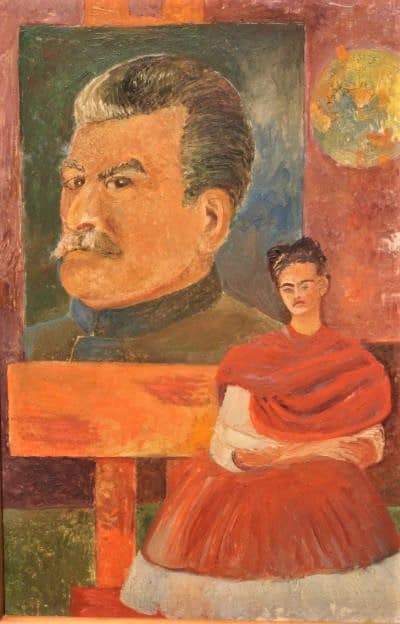
Whatever the reason, Trotsky was assassinated in 1940 by a pro-Soviet operative instructed by the Stalin’s secret police. It’s hard to understand how Frida could lionize Stalin, the man responsible for her lover’s murder, but that is just what she did. In Frida’s case it seems that politics was stronger than love.
You can visit the Trotsky house as well, which is a short walk from Frida’s home. It is much more spartan than the jaw-dropping decoration of the Blue House. Must be that Communist worker ideal. The front room has a rotating exhibition of prints, posters and other contemporary artwork related to Trotsky. There’s also a small giftshop; Capitalism lives!
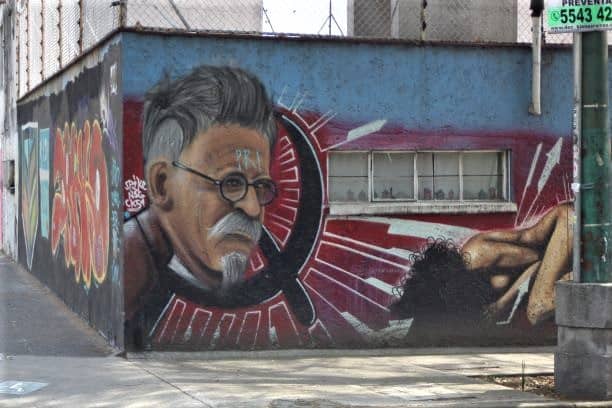
But, the real attraction is the house itself where Trotksy, his wife, and grandson lived. To me, it’s odd to think of a Communist revolutionary tending to his rabbits, but he did just that and the rabbit hutches are still in the garden. Trotsky’s bed isn’t much more than an army cot, his study is filled with rickety furniture and personal effects like his glasses. This is the definition of austure.
Hunting Huitlacoche
After a morning of museums, I asked our driver about a good place for lunch. I told him I was interested in the Mexican delicacy of huitlacoche, commonly known as corn smut, but also known as Mexican truffle. You see, I had just published my first novel, Truffle Hunt, and was interested in all kinds of edible fungi and huitlacoche was not commonly available in the US.
Huitlacoche is a fungus that grows on corn plants. In the US and Europe it is considered a blight and fungicides are often applied to crops to discourage it from forming. Corn plants that are infected with huitlacoche in the States and Europe are often destroyed or fed to cattle.

But, in Mexico, huitlacoche has been consumed for centuries and is considered a delicacy. When conditions are right, usually after it rains, the gray pillows begin to form over the kernels, swell and, finally, burst open the husk, revealing the fungus that has invaded the plant. Huitlacoche can be pureed into a sauce, used in soups, or used as a filling for quesadillas.
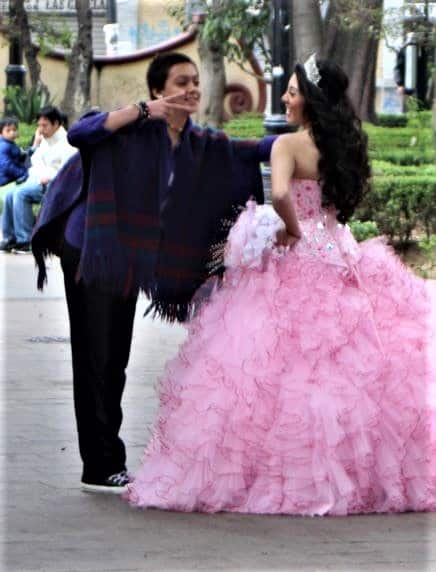
Our driver led us to Jardín Centenario, with its famous coyote fountain and recommended Ave Maria, right on the square. We asked him to join us and we sat outside. Luckily, I had my camera with me because a young woman was celebrating her quinceañera by having her picture taken in the park. Her huge pink dress was lovely and she was obviously enjoying posing for the camera when a young lady passing by jumped in and posed with her. Both ladies were in high spirits and I got some wonderful candid shots before the photobomber disappeared a few seconds later.
One of the difficulties in writing my novel was finding ways to describe the flavor of truffles. “Earthy” and “forest floor after the rain” were some of the closest I came up with and huitlacoche is the same. It has the earthy aroma and flavor of a truffle, with the umami of mushrooms. Kind of. Regardless, my huitlacoche quesadilla with mushroom was a delight.
You can find huitlacoche on the menus of many high end restaurants in Mexico City (it’s become a foodie hotspot in the last several years), but also at reasonably priced places like Ave Maria, which isn’t nearly as fancy and has atmosphere to burn right on the plaza in Colonia del Carmen.
Markets
As is true in any big city, it is important to protect yourself and your valuables when you venture out. This is especially true at the markets in Mexico City where pickpockets can be everywhere. Be aware and keep it zipped up and out of sight.
Mercado de San Juan is a culinary market that caters to locals and chefs. And those with a taste for the odd and exotic. You’ll see grasshoppers, scorpions, and other insects for sale along with wonderful rows of super-fresh fruits and vegetables. Ask questions and taste some samples. You’re sure to discover something new!
For the truly adventurous, go to the meat vendors for wild boar, ostrich, and other exotic mammals flesh. Some vendors sell what they say is lion and tiger meat; count me a skeptic. Needless to say, vegetarians should keep their distance.
La Merced is an overwhelming market of meat and vegetables and people. Lots and lots of people. Very authentic and the squeamish should stay away from the meat area where animals are butchered in the open. Best way to visit is with a guide or a local. Don’t walk here; the neighborhood is dangerous. Take the metro which drops you in the middle of the market or take a taxi.
Keep Mexico City Weird
For a real walk on the wild side, the Mercado Sonora has a witchcraft and occult section. Ignore the vendors out front with household goods and knock-off items, and turn away from the sad and malnourished animals for sale and head to the back couple of rows of the market. Here you’ll find potions, medicinal plants, incense, and lotions to fix any problem a person could have including the lovelorn. If you visit near The Day of the Dead, you’ll find plenty of trinkets for your celebration.
Santa Muerte (Saint of the Dead) has been a part of Mexican culture for a long time. But, in the last twenty years she has really come to the forefront. You know her as the skeleton often dressed as a bride, but since 2001 when Enriqueta Romero built a shine to Santa Muerte in front of her house, people have been gathering and leaving offerings. At least once a month Enriqueta or one of her sons leads a prayer at the Santuario Nacional del Angel de la Santa Muerte and recites the Santa Muerte rosary. Today, there are said to be over ten million devotees to Santa Muerte, mostly in Mexico and the southern United States.
In Mexico, death isn’t so much mourned as embraced, even celebrated. Some Americans might have trouble wrapping their heads around this, but perhaps a visit Museo de Arte Popular will help. Dedicated to the folk art of Mexico, many exhibits in the museum feature Santa Muerte and Day of the Dead themes.
Odd, quirky, and sprawling describes the Museo del Juguete Antiguo (Museum of Antique Toys). Less a formal museum than one man’s incredible collection of 55,000 toys spread over four floors. Sometimes arranged by theme, other times seemingly placed randomly, this museum never fails to delight. The first floor has a gift shop with wonderful vintage toys. Ask to be let onto the roof for a gallery of modern art and a great view of the city.
Minichelista is a restaurant founded by artists, and with one look it’s easy to tell. Bicycle frames hold up tables, weird paintings adorn the walls, and oddball sculptures populate the space. The food is good, but the atmosphere is positively Suessian.
Pasteleria Ideal might not be the best bakery in the city, but it’s pretty good and the massive scale of the place will blow your mind. And if that’s not enough, head upstairs to the cake room. Here, ginormous cakes are made for celebrations like quinceañeras and weddings, but they’re not for eating. These cakes are for decorative purposes.
Colorful Boats of Xochimilco
Ask any hotel concierge or read any guidebook on Mexico City and you’re sure to learn about the trajineras or colorful boats on the canals of Xochimilco. This is one of the most popular attractions in the city.
The canals in Xochimilco were used for centuries as the main transportation artery in the area. People have also constructed islands from juniper trees. This creates a tranquil atmosphere that is punctuated by the colorful boats filled with locals and tourists on the water.

During your ride, a local guide steers your boat through the canal system. Other boats with food and drink vendors bob along tempting you with all kinds of treats. Of course you can bring your own food, but checking out what they are selling is part of the fun. There are also the boats with mariachi bands. Pay them and they’ll sidle up to your boat and play a song or two.
If you take a longer tour you can see the Island of Dolls, a small island which has become a bizarre tourist attraction. Legend has it that a young girl drowned in the canals under mysterious circumstances. The caretaker of one of the islands in the canal found her doll in the canal and in order to pay tribute to her, hung it on a tree. He soon started hanging dozens of dolls and doll parts from trees on the island. The caretaker, Julian, died in 2001, but the dolls remained. It’s creepy, macabre, disturbing, and quite popular.
Some people come from their boat ride in the canals of Xochimilco feeling ripped off. That’s because many of the boats operate independently with no set ticket price. They often see Americans as easy marks and inflate prices for them.
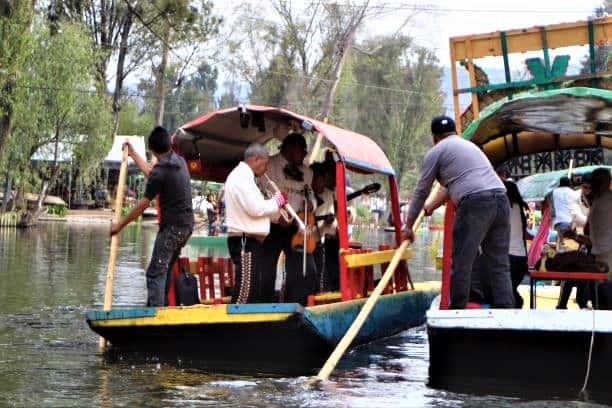
If you don’t feel comfortable negotiating, go to one of the boat docks where they sell individual seats on the boat. You won’t pay very much, but, there are no set schedules for departure; you may have to wait until they sell enough tickets on the boat for it to leave. During slow times that might take quite a while. During the weekend, on the other hand, boats tend to fill up quickly.
So, here are a few tips if you want a boat to yourself. First, you’ll have to negotiate your price. Negotiate for the full boat, not per person. The cost should be around $700 MXP. If you feel like you’re being ripped off, walk away, there are other boat operators.
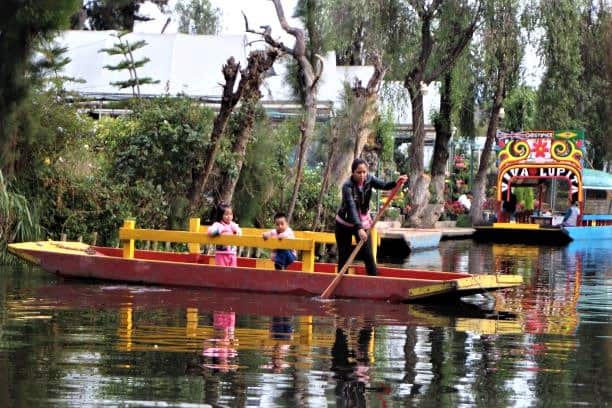
Second, go with a group. Many of the boats are large and can fit a dozen people or more. If you negotiate for the price of the boat, the cost can be split amongst your group, resulting in a very inexpensive excursion. You might be tempted to team up with another group you see on the docks in order to save money. Boat operators are wise to this maneuver and don’t allow it. Instead, get your group together well before reaching the canals.
Third, Sundays are the busiest days, but the best days in Xochimilco. That’s because it’s the day when the locals go on the canals with their families.
Fourth, tip your tour guide. They work hard steering the boat through the canals.
Finally, get in the spirit of the day. It’s fun to interact with vendors on other boats and a floating mariachi band is a blast!
Teotihuacan
1,500 years ago, Teotihuacan, aka City of the Gods, was the biggest city in the Americas with somewhere between 150,000 and 200,000 inhabitants. By the 7th or 8th century, much of the city was destroyed and the population left. There are several theories as to the reason for the city’s abandonment including sacking by an outside power, internal strife, drought, or crop failure due to a volcanic eruption.
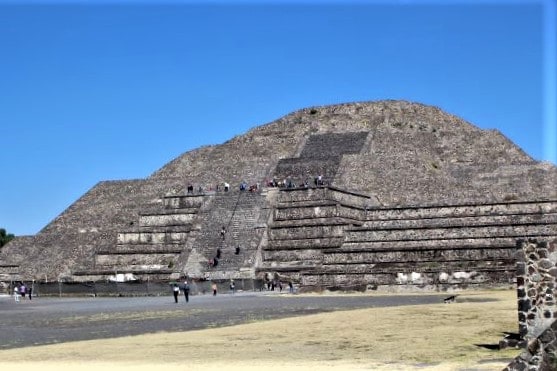
Whatever the reason, by the time the Aztecs arrived, they were just as puzzled about Teotihuacan as we are today.
Tour buses can take you out to the site for a reasonable price or you can drive yourself. Taxis are expensive as Teotihuacan is 25 miles from Mexico City.
There are also city buses that depart from Terminal del Norte (line 5) or from outside the Potrero Metro Station (line 3). Tickets on these buses are cheap, but be aware that robberies have been known to occur on them, sometimes in concert with the driver, so leave your valuables at home.
The site itself it hot and dusty with no shade as a reprieve from the heat. The concession stand keeps irregular hours so bring water, a hat, and sunscreen. Concessions are also available just outside the gate to the site.
Teotihuacan was an actual working city. The main attractions are the pyramids, the Pyramid of the Sun and the Pyramid of the Moon. The Pyramid of the Sun is the larger pyramid; in fact, it is the third largest in the world after two in Egypt. You can climb both the sun and the moon and if you are fit, you should. They both reward you with a superb vista of the city. Take breaks along the way; it’s a long climb.
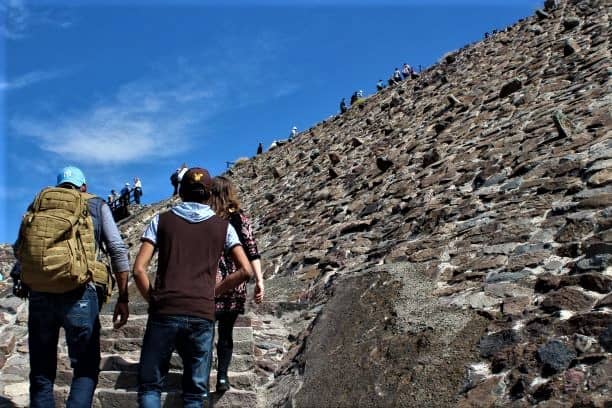
The pyramids aren’t the only attractions at Teotihuacan. There are several structures you can enter like the Palacio de los Jaguares and the Templo de los Caracoles Emplumados which has several paintings inside. There is also an excellent museum on site. Take some time to poke around as there is much more than just the pyramids. Paintings, sculptures, and carvings abound for those to take the time to look.
You will definitely be approached by vendors selling jewelry, flutes, and carved obsidian. If you’re not interested, ignore them. And whatever you do, don’t buy any “ancient artifacts” they may try to sell you. They’re fake. And even if they were real, it would be highly illegal to buy and sell them.
Transportation
Mexico City International Airport
Flights land from all over the world including most major US cities
Ground Transportation
Regulated taxis are outside the terminal at the airport. There is also bus service (Metrobus line 4) to the city. Uber is widely available in Mexico City. There is also an inconvenient Metro line that takes almost an hour to get to downtown.
Local transportation
Mexico City is crowded and sprawling. The new Metrobus is good and Metro subway system works well most of the time, but if there is a problem, gridlock ensues. Riding at night is not recommended. Women traveling alone should ride in the women-only Metro cars.
Taxis are plentiful, but Uber is cheaper. Don’t hail a taxi on the street due to safety reasons. Call the taxi service.
Index of Things to Do in Mexico City
The Blue House – Frida Kahlo Museum
The house where the iconic painter was born and lived with her husband Diego Rivera is now a museum that looks much as it did when Frida was alive. A must see.
Londres 247, Del Carmen, Coyoacán, 04100 Ciudad de México, CDMX, Mexico
Leon Trotsky house and museum
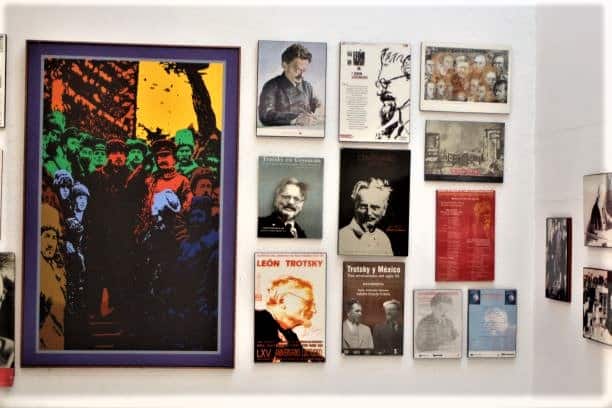
Trotsky spent the last few years of his life in Mexico City. This house, where he lived and was assassinated, is a museum located near the Blue House.
Av. Río Churubusco 410, Del Carmen, 04100 Ciudad de México, CDMX, Mexico
Santuario Nacional del Angel de la Santa Muerte
Shrine dedicated to the Holy Saint of Death. Followers leave offerings to the saint. Gift shop next door.
Nicolás Bravo 35, Zona Centro, Venustiano Carranza, 15270 Ciudad de México, CDMX, Mexico
Museo de Arte Popular
Folk art museum with many exhibits featuring Santa Muerte.
Calle Revillagigedo 11, esquina Independencia, Mexico City 06000, Mexico
Museo del Juguete Antiguo
Delightful antique toy museum.
Dr. Olvera 15, Doctores del Cuauhtémoc, Mexico City 06720, Mexico
Tacos, Beer, and Mezcal Tour
Food tours of Mexico City.
Teotihuacan
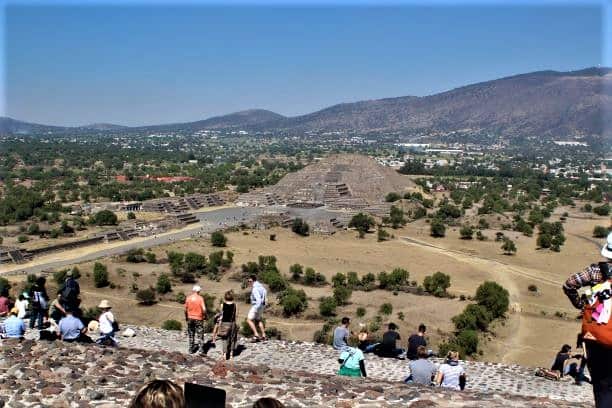
Ancient city 25 miles from Mexico City with huge pyramids.
San Juan Teotihuacán, State of Mexico, Mexico
Index of Food & Drink in Mexico City
Ave Maria Restaurante
Restaurant with a view of the Centenario Garden and Coyote Fountain. Huitlacoche is often on the menu.
Jardín Centenario No 10, Centro Histórico de Coyoacán, México D.F. 04000
Pujol
Mexico City’s top rated restaurant. Huitlachoche on the menu seasonally.
Tennyson 133, Polanco, Polanco IV Secc, Miguel Hidalgo, 11550 Ciudad de México, CDMX, Mexico
Lorea
Upscale restaurant often has Huitlacoche on the menu in season (June-Sept)
Sinaloa, Del. Cuauhtémoc 141, Roma Nte., Cuauhtémoc, 06700 Ciudad de México, CDMX, Mexico
El Vilsito
Auto repair shop by day, amazing taqueria by night. The place to get tacos al pastor,
Avenida Universidad 248 Col. Narvarte, Mexico City 03020 Mexico
Pasteleria Ideal
There might be better bakeries in Mexico City, but the massive cakes on the second floor are breathtaking.
República de Uruguay 74, Centro, 06000 Cuauhtémoc, CDMX, Mexico
Cafebreria El Pendulo
Bookstore, record shop and café in a unique setting in Zona Rosa.
Calle Hamburgo 126 Col. Juárez 06600 México, D.F.
Minichelista
Restaurant founded by artists and oddly decorated.
Calle Guanabana 197, Col. Nueva Santa Maria, Mexico City 02800, Mexico
Mezcalero
The place for Mezcal cocktails
Caballo Calco 14B, Mexico City 04000, Mexico
Bósforo Mezcaleria
Dive bar with a great selection of artisan Mezcal.
Luis Moya 31, Colonia Centro, Centro, 06000 Centro, CDMX, Mexico
Index of Shopping in Mexico City
Mercado de San Juan
High quality produce and (especially) meat, some of which is butchered right in front of your eyes.
Calle de Ernesto Pugibet No. 21, Mexico City
La Merced
Huge down n dirty market with a produce section and a meat section. Can be extremely crowded.
Rosario 180, Venustiano Carranza, 15810, Mexico City
Mercado de comida de Coyoacán
Local market with food vendors. Look for Huitlacoche quesadillas in season.
Higuera 30, La Candelaria, Coyoacán, 04100 Ciudad de México, CDMX, Mexico
Mercado Sonora
Witchcraft market with a potion for what ails ya.
Fray Servando 419, Venustiano Carranza, Distrito Federal, Mexico 15800
Fabrica Social
Homemade clothing and crafts benefiting the artists and their communities.
C. Dinamarca 66, Juárez, Cuauhtémoc, 06600 Ciudad de México, CDMX, Mexico
Fonart
Government sponsored program ensures the money from your purchase of artwork here goes to the artists.
Avenida Patriotismo 691 col. Mixcoac, Mexico City, Mexico 03730
Centro Artesanal La Ciudadela
Colorful local crafts in a covered market with over 200 stalls.
Calle Baldera 6, Enrico Martinez, Mexico City 06040, Mexico
Index of Places to Stay in Mexico City
Gran Hotel Cuidad
The opulent Tiffany ceiling in the lobby is worth seeing even if you don’t stay here. But, it is a great place to stay as well. Right on the Plaza de la Constitucion in the center of town.
Calle 16 de Septiembre 82, Col. Centro Historico, Mexico City 06000, Mexico
Hotel Histórico Central
Nice hotel right in the historic center.
Calle Bolivar 28, Historic City Center, Mexico City 06000, Mexico
Zocolo Central
Great location in the heart of the historic center.
Avenida Cinco De Mayo 61, Mexico City 06000, Mexico
Hippodrome Hotel
Close to several parks in the hip Condesa neighborhood.
Avenida Mexico 188, Col. La Condesa, Mexico City 06100, Mexico
Casa Jacinta Guest House
Cute boutique hotel, 10 minute walk to the Frida House/Museum.
2da. Cerrada de Belisario Dominguez #22, Del Carmen, Coyoacan, Mexico City 04100, Mexico
Real del Sur
Cheap hotel with a convenient location in Frida’s old neighborhood. Don’t expect much in the way of amenities.
Avenida Division Del Norte No. 3640, Mexico City 04620, Mexico
About the Author

Brent Petersen is the Editor-in-Chief of Destination Eat Drink. He currently resides in Setubal, Portugal. Brent has written the novel “Truffle Hunt” (Eckhartz Press) and the short story collection “That Bird.” He’s also written dozens of foodie travel guides to cities around the world on Destination Eat Drink. Brent’s podcast, also called Destination Eat Drink, is available on all major podcasting platforms and is distributed by the Radio Misfits Podcast Network.
